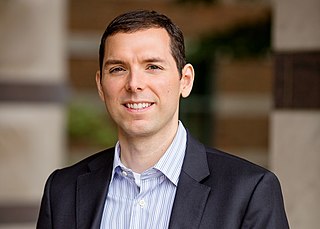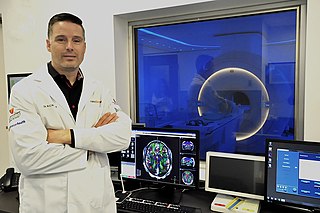A brain–computer interface (BCI), sometimes called a brain–machine interface (BMI), is a direct communication pathway between the brain's electrical activity and an external device, most commonly a computer or robotic limb. BCIs are often directed at researching, mapping, assisting, augmenting, or repairing human cognitive or sensory-motor functions. Implementations of BCIs range from non-invasive and partially invasive to invasive, based on how close electrodes get to brain tissue.
Eugène Paul Louis Schueller was a French pharmacist and entrepreneur who was the founder of L'Oréal, the world's leading company in cosmetics and beauty. He was one of the founders of modern advertising.
The Society for Neuroscience (SfN) is a professional society, headquartered in Washington, DC, for basic scientists and physicians around the world whose research is focused on the study of the brain and nervous system. It is especially well known for its annual meeting, consistently one of the largest scientific conferences in the world.
EEGLAB is a MATLAB toolbox distributed under the free BSD license for processing data from electroencephalography (EEG), magnetoencephalography (MEG), and other electrophysiological signals. Along with all the basic processing tools, EEGLAB implements independent component analysis (ICA), time/frequency analysis, artifact rejection, and several modes of data visualization. EEGLAB allows users to import their electrophysiological data in about 20 binary file formats, preprocess the data, visualize activity in single trials, and perform ICA. Artifactual ICA components may be subtracted from the data. Alternatively, ICA components representing brain activity may be further processed and analyzed. EEGLAB also allows users to group data from several subjects, and to cluster their independent components.
Erich Jarvis is an American professor at The Rockefeller University. He leads a team of researchers who study the neurobiology of vocal learning, a critical behavioral substrate for spoken language. The animal models he studies include songbirds, parrots, and hummingbirds. Like humans, these bird groups have the ability to learn new sounds and pass on their vocal repertoires culturally, from one generation to the next. Jarvis focuses on the molecular pathways involved in the perception and production of learned vocalizations, and the development of brain circuits for vocal learning.

Michael T. Ullman is an American neuroscientist whose main field of research is the relationship between language, memory and the brain. His Declarative/Procedural model of language has greatly affected the field of psycholinguistics and cognitive neuroscience.

Electroencephalography (EEG) is a method to record an electrogram of the electrical activity on the scalp that has been shown to represent the macroscopic activity of the surface layer of the brain underneath. It is typically non-invasive, with the electrodes placed along the scalp. Electrocorticography, involving invasive electrodes, is sometimes called intracranial EEG.
Jerome "Jerry" Swartz is a physicist that developed early optical strategies for barcode scanning technologies in the United States and co-founded the corporation, Symbol Technologies on Long Island, New York, with physicist partner, Dr. Shelley A. Harrison in 1973. Swartz was President, becoming the Chairman and Chief Scientist in 1982. In 2006 Symbol Technologies became a wholly owned subsidiary of the multinational telecommunications manufacturer, Motorola Corporation.
The Human Connectome Project (HCP) is a five-year project sponsored by sixteen components of the National Institutes of Health, split between two consortia of research institutions. The project was launched in July 2009 as the first of three Grand Challenges of the NIH's Blueprint for Neuroscience Research. On September 15, 2010, the NIH announced that it would award two grants: $30 million over five years to a consortium led by Washington University in Saint Louis and the University of Minnesota, with strong contributions from Oxford University (FMRIB) and $8.5 million over three years to a consortium led by Harvard University, Massachusetts General Hospital and the University of California Los Angeles.
Anders Martin Dale is a prominent neuroscientist and Professor of Radiology, Neurosciences, Psychiatry, and Cognitive Science at the University of California, San Diego (UCSD), and is one of the world's leading developers of sophisticated computational neuroimaging techniques. He is the founding Director of the Center for Multimodal Imaging Genetics (CMIG) at UCSD.

Pedro Antonio Valdes-Sosa, is the General Vice-Director for Research of the Cuban Neurosciences Center, which he cofounded in 1990. He is also Member of the Editorial Boards of the following journals: Neuroimage, Medicc, Audiology and Neurotology, PLosOne Frontiers, Neuroimage and Brain Connectivity. His work includes statistical analysis of electrophysiological measurements, neuroimaging, nonlinear dynamical modeling of brain functions and Software and electrophysiological equipment development.
The Association Medicine / Pharmacy Sciences (AMPS) is an association of French students of medicine and pharmacy.

Geoffrey S. F. Ling, M.D., Ph.D., is the CEO of On Demand Pharmaceuticals. He is also a medical doctor who retired from the United States Army as a colonel. He served as the founding director of the Defense Advanced Research Projects Agency (DARPA) Biological Technologies Office from 2014 until 2016. He was considered to be the "US Army's premier subject matter expert on traumatic brain injury (TBI)", and was for years the only neuro-intensive care specialist in the US military.

John O'Keefe, is an American-British neuroscientist, psychologist and a professor at the Sainsbury Wellcome Centre for Neural Circuits and Behaviour and the Research Department of Cell and Developmental Biology at University College London. He discovered place cells in the hippocampus, and that they show a specific kind of temporal coding in the form of theta phase precession. He shared the Nobel Prize in Physiology or Medicine in 2014, together with May-Britt Moser and Edvard Moser; he has received several other awards. He has worked at University College London for his entire career, but also held a part-time chair at the Norwegian University of Science and Technology at the behest of his Norwegian collaborators, the Mosers.

Aron Keith Barbey is an American cognitive neuroscientist, who investigates the neural architecture of human intelligence and brain plasticity. Barbey is the Emanuel Donchin Professorial Scholar of Psychology and a Professor of Psychology, Neuroscience, and Bioengineering at the University of Illinois. He is director of the Decision Neuroscience Laboratory at the Beckman Institute for Advanced Science and Technology, and founding director of the Center for Brain Plasticity at the Beckman Institute, where he leads the Intelligence, Learning, and Plasticity (ILP) Initiative.

Adam Gazzaley is an American neuroscientist, author, photographer, entrepreneur and inventor. He is the founder and executive director of Neuroscape and the David Dolby Distinguished Professor of Neurology, Physiology, and Psychiatry at University of California, San Francisco (UCSF). He is co-founder and chief science advisor of Akili Interactive Labs and JAZZ Venture Partners. Gazzaley is the inventor of the first video game approved by the FDA as a medical treatment. He is a board of trustee member, science council member and fellow of the California Academy of Sciences. He has authored over 160 scientific articles.

Ryan C.N. D'Arcy is a Canadian neuroscientist, researcher, innovator and entrepreneur. D'Arcy co-founded HealthTech Connex Inc. and serves as President and Chief Scientific Officer. HealthTech Connex translates neuroscience advances into health technology breakthroughs. D'Arcy is most known for coining the term "brain vital signs" and for leading the research and development of the brain vital signs framework.

Brain Electrical Oscillation Signature Profiling is an EEG technique by which a suspect's participation in a crime is detected by eliciting electrophysiological impulses.
Conor Russomanno is an entrepreneur, creative technologist, and lecturer, specializing in the development of advanced human-computer interfaces. He is the co-founder and CEO of OpenBCI, a company dedicated to open source innovation of brain-computer interface technologies. Conor is also a teacher, having taught graduate level courses at Parsons School of Design and NYU Tisch School of the Arts.
Jawad Youssef Fares is a Lebanese medical doctor, researcher and scientist. He was selected for the Forbes 30 Under 30 list in science and healthcare for his contribution to solving healthcare problems in the developing world. He also featured twice in the Forbes Middle East 30 Under 30, and was selected as one of the top 10 young scientists in the world by Genetic Engineering and Biotechnology News. In 2019, Fares was elected as a Fellow of The World Academy of Medical Sciences, and in 2021 was one of the Young Physician Leaders selected by the InterAcademy Partnership.








